ECU MITSUBISHI OUTLANDER SPORT 2017 3.G Owners Manual
[x] Cancel search | Manufacturer: MITSUBISHI, Model Year: 2017, Model line: OUTLANDER SPORT, Model: MITSUBISHI OUTLANDER SPORT 2017 3.GPages: 399, PDF Size: 14.61 MB
Page 9 of 399
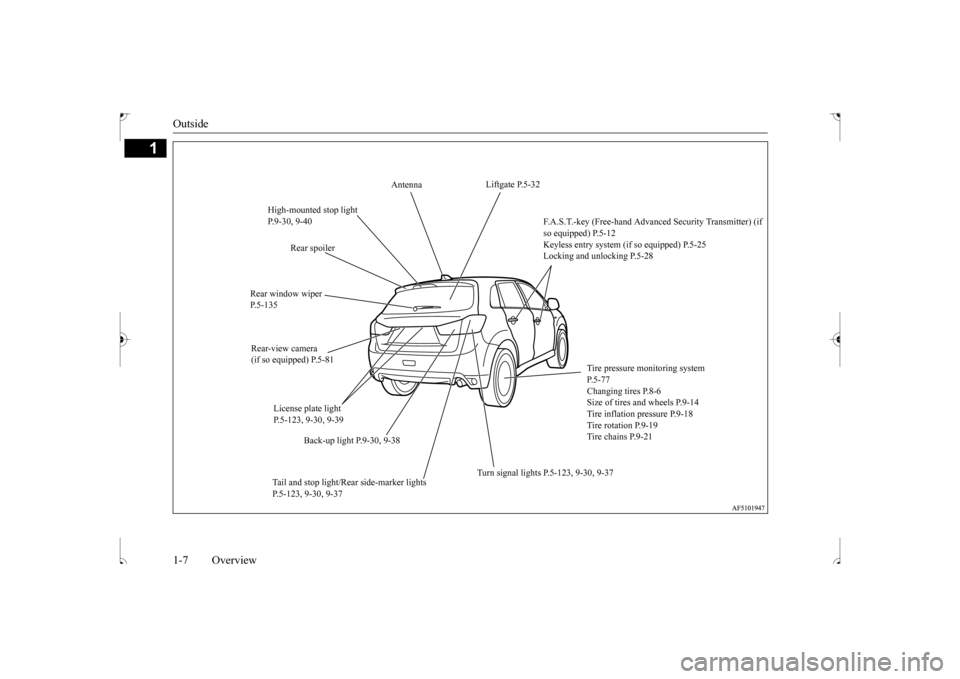
Outside 1-7 Overview
1
Liftgate P.5-32
Antenna
High-mounted stop light P.9-30, 9-40
F.A.S.T.-key (Free-hand Adva
nced Security Transmitter) (if
so equipped) P.5-12 Keyless entry system (if so equipped) P.5-25 Locking and unlocking P.5-28
Rear spoiler
Rear window wiper P.5-135 Rear-view camera (if so equipped) P.5-81
Tire pressure monitoring system P.5-77 Changing tires P.8-6Size of tires and wheels P.9-14 Tire inflation pressure P.9-18 Tire rotation P.9-19 Tire chains P.9-21
License plate light P.5-123, 9-30, 9-39
Back-up light P.9-30, 9-38
Turn signal lights P.5-123, 9-30, 9-37
Tail and stop light/Rear side-marker lights P.5-123, 9-30, 9-37
BK0239500US.bo
ok 7 ページ 2016年5月13日 金曜日 午前8時53分
Page 20 of 399
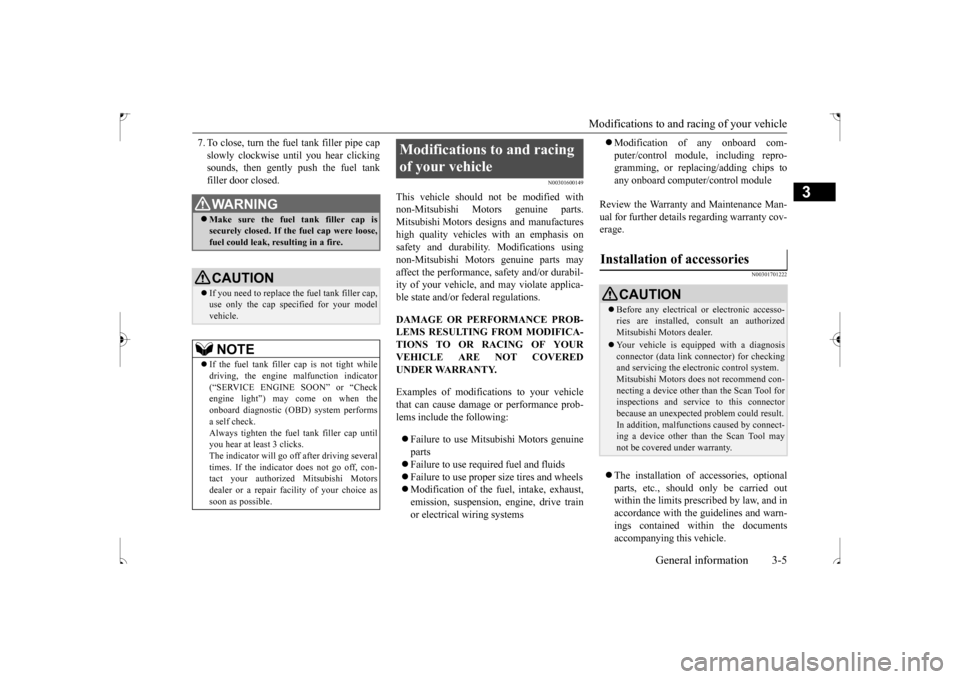
Modifications to and racing of your vehicle
General information 3-5
3
7. To close, turn the fuel tank filler pipe cap slowly clockwise until you hear clicking sounds, then gently push the fuel tank filler door closed.
N00301600149
This vehicle should not be modified withnon-Mitsubishi Motors genuine parts.Mitsubishi Motors designs and manufactures high quality vehicles
with an emphasis on
safety and durability. Modifications usingnon-Mitsubishi Motors genuine parts may affect the performance, safety and/or durabil- ity of your vehicle, and may violate applica-ble state and/or federal regulations. DAMAGE OR PERFORMANCE PROB- LEMS RESULTING FROM MODIFICA- TIONS TO OR RACING OF YOUR VEHICLE ARE NOT COVEREDUNDER WARRANTY. Examples of modifications to your vehicle that can cause damage or performance prob- lems include the following: Failure to use Mitsubishi Motors genuine parts Failure to use required fuel and fluids Failure to use proper size tires and wheels Modification of the fuel, intake, exhaust, emission, suspension, engine, drive train or electrical wiring systems
Modification of any onboard com- puter/control module, including repro- gramming, or replacing/adding chips to any onboard computer/control module
Review the Warranty and Maintenance Man- ual for further details regarding warranty cov- erage.
N00301701222
The installation of accessories, optional parts, etc., should only be carried out within the limits prescribed by law, and in accordance with the guidelines and warn-ings contained within the documents accompanying this vehicle.
WA R N I N G Make sure the fuel tank filler cap is securely closed. If the fuel cap were loose, fuel could leak, resulting in a fire.CAUTION If you need to replace the fuel tank filler cap, use only the cap specified for your model vehicle.NOTE
If the fuel tank filler cap
is not tight while
driving, the engine malfunction indicator (“SERVICE ENGINE SOON” or “Checkengine light”) may come on when the onboard diagnostic (OBD) system performs a self check. Always tighten the fuel tank filler cap until you hear at least 3 clicks.The indicator will go off after driving several times. If the indicator does not go off, con- tact your authorized Mitsubishi Motorsdealer or a repair f
acility of your choice as
soon as possible.
Modifications to and racing of your vehicle
Installation of accessories
CAUTION Before any electrical or electronic accesso- ries are installed, consult an authorized Mitsubishi Motors dealer. Your vehicle is equipped with a diagnosis connector (data link connector) for checkingand servicing the electronic control system. Mitsubishi Motors does not recommend con- necting a device other than the Scan Tool forinspections and service to this connector because an unexpected problem could result. In addition, malfunctions caused by connect-ing a device other than the Scan Tool may not be covered under warranty.
BK0239500US.bo
ok 5 ページ 2016年5月13日 金曜日 午前8時53分
Page 23 of 399
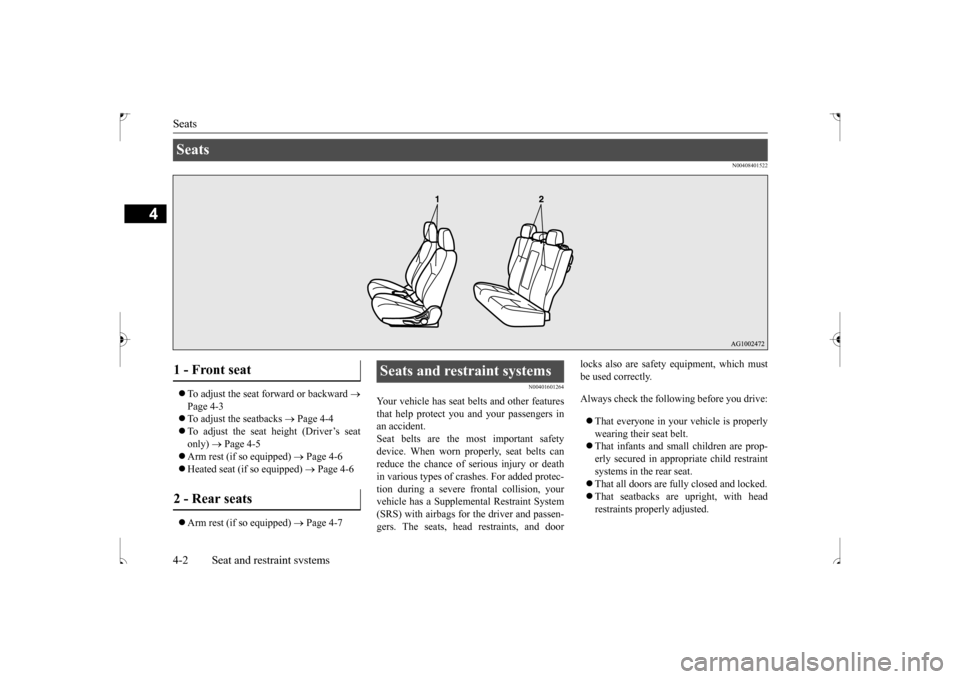
Seats 4-2 Seat and restraint systems
4
N00408401522
To adjust the seat forward or backward
Page 4-3 To adjust the seatbacks
Page 4-4
To adjust the seat height (Driver’s seat only)
Page 4-5
Arm rest (if so equipped)
Page 4-6
Heated seat (if so equipped)
Page 4-6
Arm rest (if so equipped)
Page 4-7
N00401601264
Your vehicle has seat belts and other features that help protect you and your passengers in an accident. Seat belts are the most important safetydevice. When worn properly, seat belts can reduce the chance of serious injury or death in various types of crashes. For added protec-tion during a severe frontal collision, your vehicle has a Supplemental Restraint System (SRS) with airbags for the driver and passen-gers. The seats, head restraints, and door
locks also are safety equipment, which must be used correctly. Always check the following before you drive: That everyone in your vehicle is properly wearing their seat belt. That infants and small children are prop- erly secured in appropriate child restraint systems in the rear seat. That all doors are fully closed and locked. That seatbacks are upright, with head restraints properly adjusted.
Seats 1 - Front seat 2 - Rear seats
Seats and restraint systems
BK0239500US.bo
ok 2 ページ 2016年5月13日 金曜日 午前8時53分
Page 24 of 399
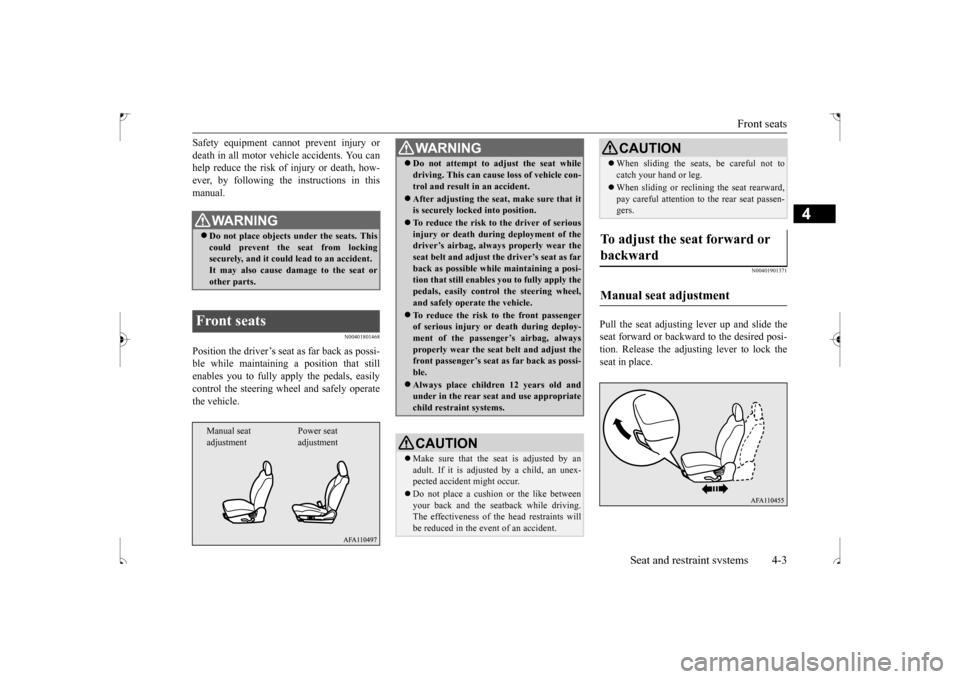
Front seats
Seat and restraint systems 4-3
4
Safety equipment cannot prevent injury or death in all motor vehicle accidents. You can help reduce the risk of injury or death, how- ever, by following the
instructions in this
manual.
N00401801468
Position the driver’s seat
as far back as possi-
ble while maintaining a position that still enables you to fully apply the pedals, easilycontrol the steering wheel and safely operate the vehicle.
N00401901371
Pull the seat adjusting lever up and slide the seat forward or backward to the desired posi-tion. Release the adjusting lever to lock the seat in place.
WA R N I N G Do not place objects under the seats. This could prevent the seat from locking securely, and it could lead to an accident.It may also cause damage to the seat or other parts.
Front seats Manual seat adjustment
Power seat adjustment
WA R N I N G Do not attempt to adjust the seat while driving. This can cause loss of vehicle con- trol and result in an accident. After adjusting the seat, make sure that it is securely locked into position. To reduce the risk to the driver of serious injury or death during deployment of the driver’s airbag, always properly wear the seat belt and adjust th
e driver’s seat as far
back as possible while maintaining a posi- tion that still enables
you to fully apply the
pedals, easily control the steering wheel,and safely operate the vehicle. To reduce the risk to the front passenger of serious injury or death during deploy- ment of the passenger’s airbag, always properly wear the seat belt and adjust thefront passenger’s seat as far back as possi- ble. Always place children 12 years old and under in the rear seat and use appropriate child restraint systems.CAUTION Make sure that the seat is adjusted by an adult. If it is adjusted by a child, an unex-pected accident might occur. Do not place a cushion or the like between your back and the seatback while driving. The effectiveness of the head restraints will be reduced in the event of an accident.
When sliding the seats, be careful not to catch your hand or leg. When sliding or reclining the seat rearward, pay careful attention to the rear seat passen-gers.
To adjust the seat forward or backward Manual seat adjustment
CAUTION
BK0239500US.bo
ok 3 ページ 2016年5月13日 金曜日 午前8時53分
Page 25 of 399
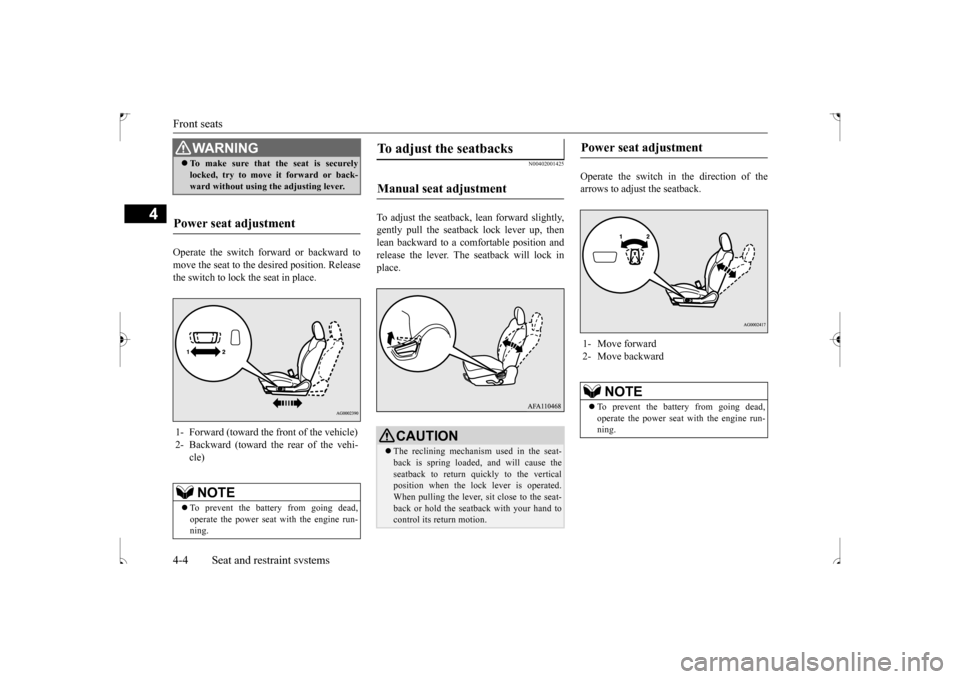
Front seats 4-4 Seat and restraint systems
4
Operate the switch forward or backward to move the seat to the desired position. Releasethe switch to lock the seat in place.
N00402001425
To adjust the seatback,
lean forward slightly,
gently pull the seatb
ack lock lever up, then
lean backward to a comfortable position and release the lever. The seatback will lock in place.
Operate the switch in the direction of the arrows to adjust the seatback.
WA R N I N G To make sure that the seat is securely locked, try to move it forward or back- ward without using the adjusting lever.
Power seat adjustment 1- Forward (toward the front of the vehicle) 2- Backward (toward the rear of the vehi-
cle)NOTE
To prevent the battery from going dead, operate the power seat with the engine run- ning.
To adjust the seatbacks Manual seat adjustment
CAUTION The reclining mechanism used in the seat- back is spring loaded, and will cause the seatback to return quickly to the vertical position when the lock lever is operated.When pulling the lever, sit close to the seat- back or hold the seatback with your hand to control its return motion.
Power seat adjustment 1- Move forward 2- Move backward
NOTE
To prevent the battery from going dead, operate the power seat with the engine run- ning.
BK0239500US.bo
ok 4 ページ 2016年5月13日 金曜日 午前8時53分
Page 30 of 399
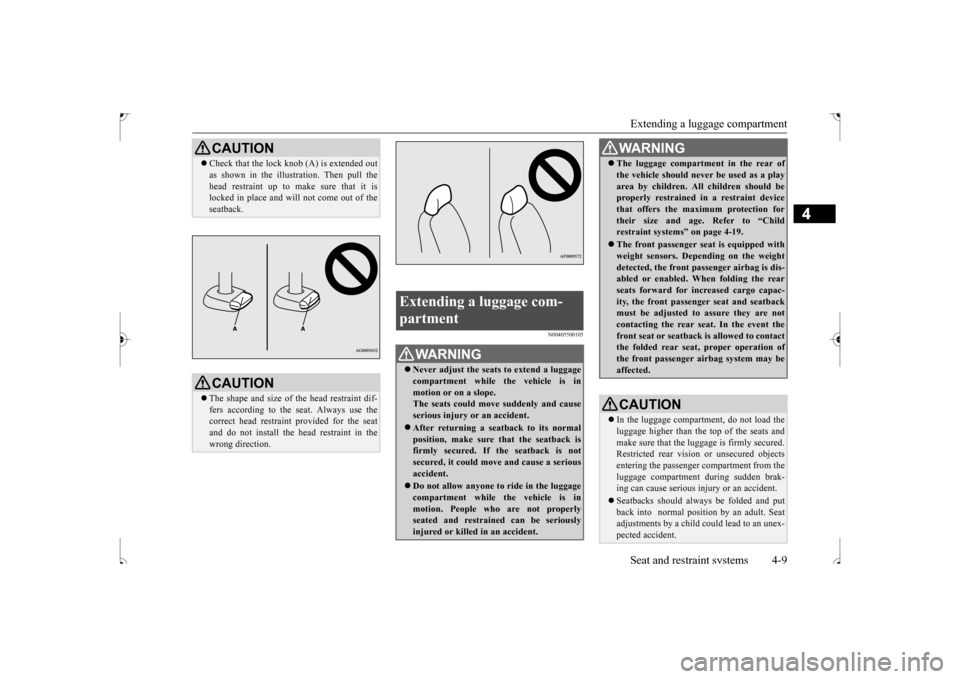
Extending a luggage compartment Seat and restraint systems 4-9
4
N00405500105
CAUTION Check that the lock knob (A) is extended out as shown in the illustration. Then pull the head restraint up to make sure that it is locked in place and will not come out of the seatback.CAUTION The shape and size of the head restraint dif- fers according to the seat. Always use the correct head restraint provided for the seatand do not install the head restraint in the wrong direction.
Extending a luggage com- partment
WA R N I N G Never adjust the seats to extend a luggage compartment while the vehicle is inmotion or on a slope. The seats could move suddenly and cause serious injury or an accident. After returning a seatback to its normal position, make sure that the seatback isfirmly secured. If the seatback is not secured, it could move and cause a serious accident. Do not allow anyone to
ride in the luggage
compartment while the vehicle is inmotion. People who are not properly seated and restrained can be seriously injured or killed in an accident.
The luggage compartment in the rear of the vehicle should never be used as a play area by children. All children should be properly restrained in a restraint device that offers the maximum protection fortheir size and age. Refer to “Child restraint systems” on page 4-19. The front passenger seat is equipped with weight sensors. Depending on the weight detected, the front passenger airbag is dis-abled or enabled. When folding the rear seats forward for increased cargo capac- ity, the front passenger seat and seatbackmust be adjusted to assure they are not contacting the rear seat. In the event the front seat or seatback is allowed to contactthe folded rear seat, proper operation of the front passenger airbag system may be affected.CAUTION In the luggage compartment, do not load the luggage higher than the top of the seats and make sure that the luggage is firmly secured. Restricted rear vision or unsecured objects entering the passenger compartment from the luggage compartment during sudden brak-ing can cause serious injury or an accident. Seatbacks should always be folded and put back into normal position by an adult. Seat adjustments by a child could lead to an unex- pected accident.WA R N I N G
BK0239500US.bo
ok 9 ページ 2016年5月13日 金曜日 午前8時53分
Page 31 of 399
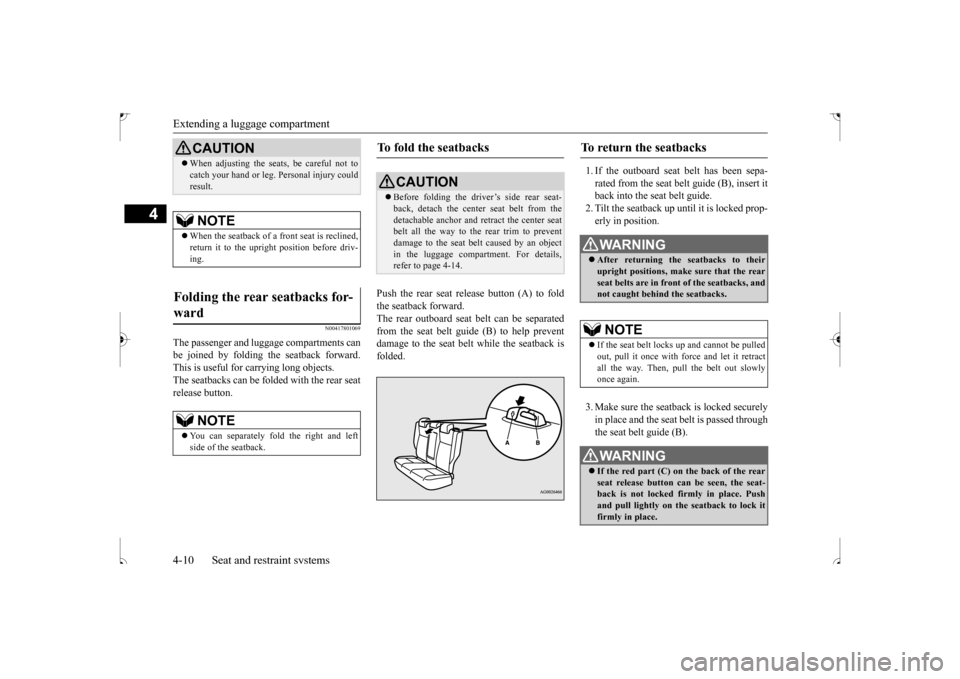
Extending a luggage compartment 4-10 Seat and restraint systems
4
N00417801069
The passenger and luggage compartments can be joined by folding the seatback forward. This is useful for carrying long objects.The seatbacks can be folded with the rear seat release button.
Push the rear seat release button (A) to fold the seatback forward.The rear outboard seat belt can be separated from the seat belt guide (B) to help prevent damage to the seat belt while the seatback isfolded.
1. If the outboard seat belt has been sepa- rated from the seat belt guide (B), insert it back into the seat belt guide.2. Tilt the seatback up until it is locked prop- erly in position. 3. Make sure the seatback is locked securely in place and the seat belt is passed through the seat belt guide (B).
When adjusting the seats, be careful not to catch your hand or leg. Personal injury could result.NOTE
When the seatback of a front seat is reclined, return it to the upright position before driv- ing.
Folding the rear seatbacks for- ward
NOTE
You can separately fold the right and left side of the seatback.CAUTION
To fold the seatbacks
CAUTION Before folding the driver’s side rear seat- back, detach the center seat belt from the detachable anchor and retract the center seat belt all the way to the rear trim to preventdamage to the seat belt caused by an object in the luggage compartment. For details, refer to page 4-14.
To return the seatbacks
WA R N I N G After returning the seatbacks to their upright positions, make sure that the rear seat belts are in front of the seatbacks, andnot caught behind the seatbacks.NOTE
If the seat belt locks up and cannot be pulled out, pull it once with force and let it retractall the way. Then, pull the belt out slowly once again.WA R N I N G If the red part (C) on the back of the rear seat release button can be seen, the seat- back is not locked firmly in place. Pushand pull lightly on the
seatback to lock it
firmly in place.
BK0239500US.bo
ok 10 ページ 2016年5月13日 金曜日 午前8時53分
Page 32 of 399
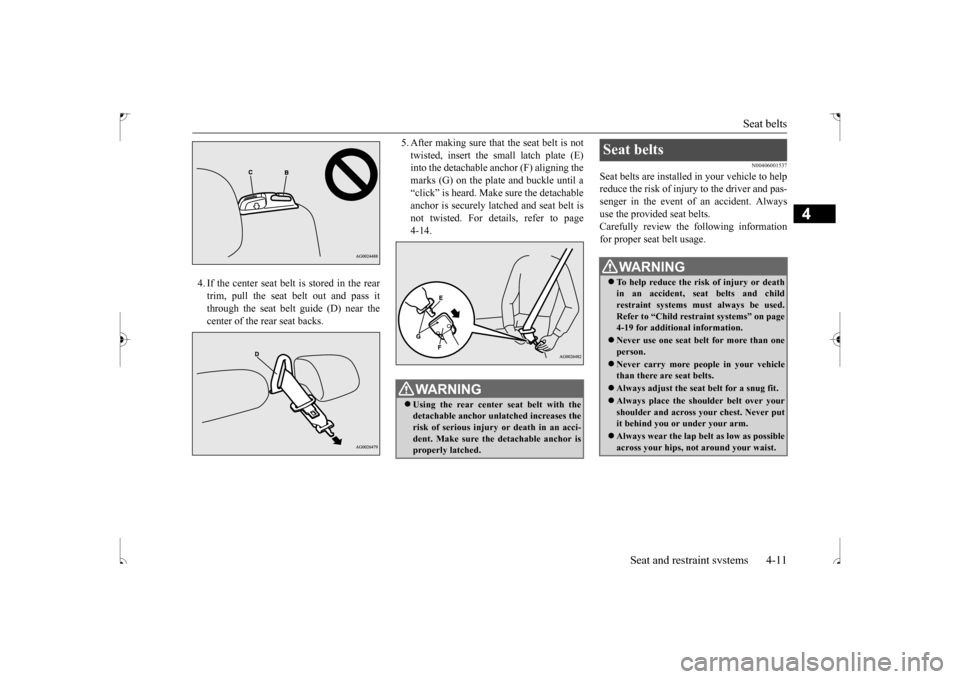
Seat belts
Seat and restraint systems 4-11
4
4. If the center seat belt is stored in the rear trim, pull the seat belt out and pass it through the seat belt guide (D) near thecenter of the rear seat backs.
5. After making sure that the seat belt is not twisted, insert the small latch plate (E) into the detachable anchor (F) aligning the marks (G) on the plate and buckle until a“click” is heard. Make sure the detachable anchor is securely latched and seat belt is not twisted. For details, refer to page4-14.
N00406001537
Seat belts are installed in your vehicle to helpreduce the risk of injury to the driver and pas-senger in the event of an accident. Always use the provided seat belts. Carefully review the following informationfor proper seat belt usage.
WA R N I N G Using the rear center seat belt with the detachable anchor unlatched increases therisk of serious injury or death in an acci- dent. Make sure the detachable anchor is properly latched.
Seat belts
WA R N I N G To help reduce the risk of injury or death in an accident, seat belts and child restraint systems must always be used.Refer to “Child restraint systems” on page 4-19 for additional information. Never use one seat belt for more than one person. Never carry more people in your vehicle than there are seat belts. Always adjust the seat belt for a snug fit.Always place the shoulder belt over your shoulder and across your chest. Never put it behind you or under your arm. Always wear the lap belt as low as possible across your hips, not around your waist.
BK0239500US.bo
ok 11 ページ 2016年5月13日 金曜日 午前8時53分
Page 34 of 399
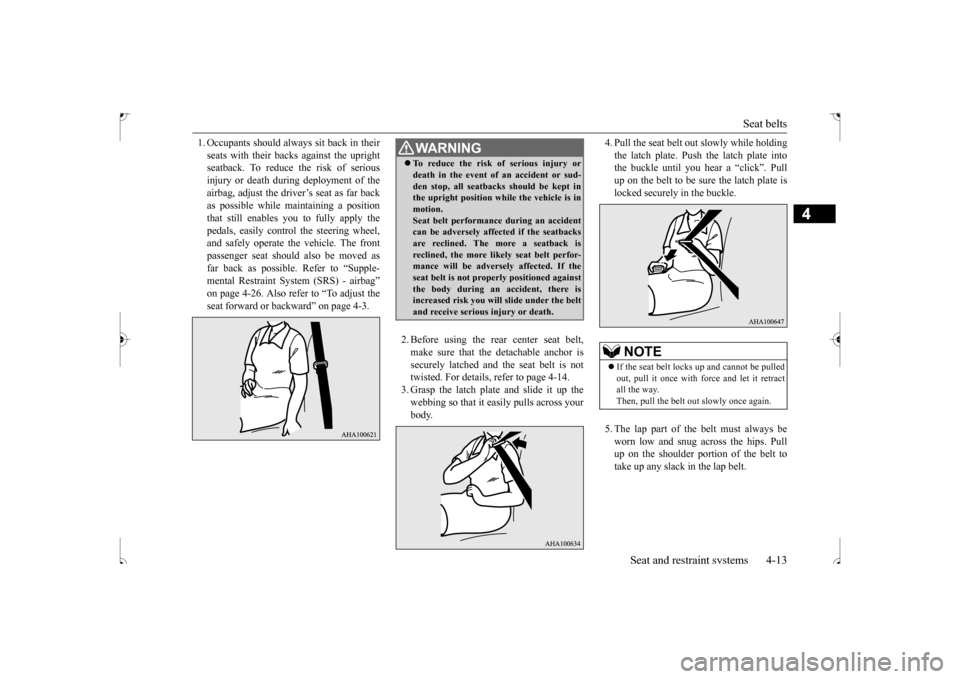
Seat belts
Seat and restraint systems 4-13
4
1. Occupants should always sit back in their seats with their backs against the upright seatback. To reduce the risk of serious injury or death during deployment of theairbag, adjust the driver’s seat as far back as possible while maintaining a position that still enables you to fully apply thepedals, easily control the steering wheel, and safely operate the vehicle. The front passenger seat should also be moved asfar back as possible. Refer to “Supple-mental Restraint System (SRS) - airbag” on page 4-26. Also refer to “To adjust the seat forward or backward” on page 4-3.
2. Before using the rear center seat belt, make sure that the detachable anchor issecurely latched and the seat belt is not twisted. For details, refer to page 4-14. 3. Grasp the latch plate and slide it up thewebbing so that it easily pulls across your body.
4. Pull the seat belt out slowly while holding the latch plate. Push the latch plate into the buckle until you hear a “click”. Pull up on the belt to be sure the latch plate islocked securely in the buckle. 5. The lap part of the belt must always be worn low and snug across the hips. Pull up on the shoulder portion of the belt to take up any slack in the lap belt.
WA R N I N G To reduce the risk of serious injury or death in the event of an accident or sud- den stop, all seatbacks should be kept in the upright position while the vehicle is in motion.Seat belt performance during an accident can be adversely affected if the seatbacks are reclined. The more a seatback isreclined, the more likely seat belt perfor- mance will be adversely affected. If the seat belt is not properly positioned againstthe body during an accident, there is increased risk you will slide under the belt and receive serious injury or death.
NOTE
If the seat belt locks up and cannot be pulled out, pull it once with force and let it retractall the way. Then, pull the belt out slowly once again.
BK0239500US.bo
ok 13 ページ 2016年5月13日 金曜日 午前8時53分
Page 37 of 399
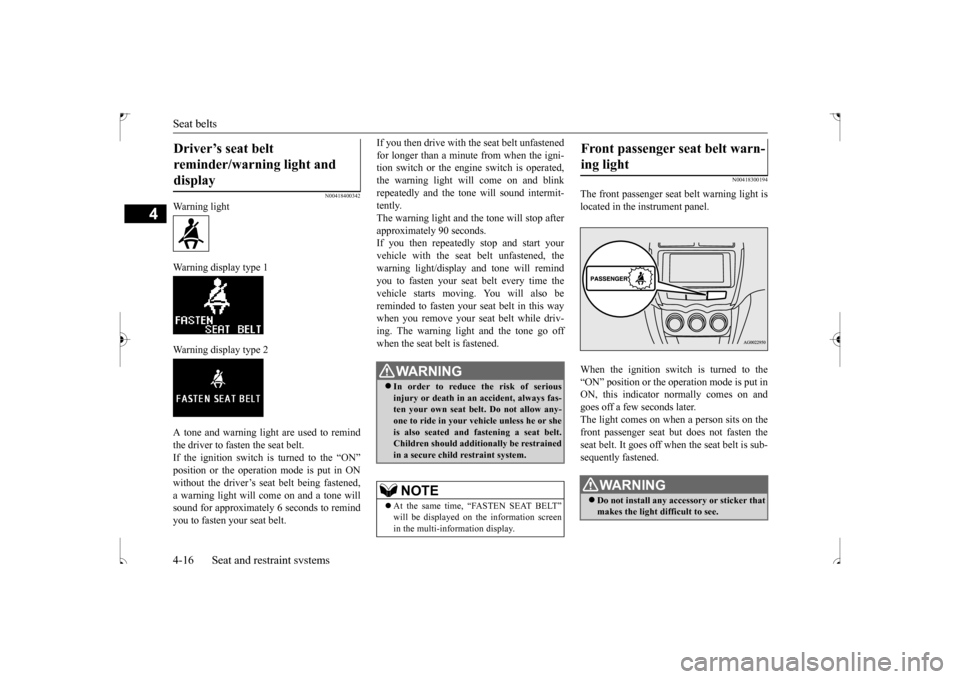
Seat belts 4-16 Seat and restraint systems
4
N00418400342
Warning light Warning display type 1 Warning display type 2 A tone and warning light are used to remind the driver to fasten the seat belt.If the ignition switch is turned to the “ON” position or the operation mode is put in ON without the driver’s seat belt being fastened,a warning light will come on and a tone will sound for approximately 6 seconds to remind you to fasten your seat belt.
If you then drive with the seat belt unfastened for longer than a minute from when the igni- tion switch or the engine switch is operated, the warning light will come on and blinkrepeatedly and the tone will sound intermit- tently. The warning light and the tone will stop afterapproximately 90 seconds. If you then repeatedly stop and start your vehicle with the seat belt unfastened, thewarning light/display and tone will remindyou to fasten your seat belt every time the vehicle starts moving. You will also be reminded to fasten your seat belt in this waywhen you remove your seat belt while driv- ing. The warning light and the tone go off when the seat belt is fastened.
N00418300194
The front passenger seat belt warning light islocated in the instrument panel. When the ignition switch is turned to the “ON” position or the operation mode is put inON, this indicator normally comes on andgoes off a few seconds later. The light comes on when a person sits on the front passenger seat but does not fasten theseat belt. It goes off when the seat belt is sub- sequently fastened.
Driver’s seat belt reminder/warning light and display
WA R N I N G In order to reduce the risk of serious injury or death in an accident, always fas- ten your own seat belt. Do not allow any-one to ride in your vehicle unless he or she is also seated and fastening a seat belt. Children should additionally be restrained in a secure child restraint system.NOTE
At the same time, “FASTEN SEAT BELT” will be displayed on the information screen in the multi-information display.
Front passenger seat belt warn- ing light
WA R N I N G Do not install any accessory or sticker that makes the light difficult to see.
BK0239500US.bo
ok 16 ページ 2016年5月13日 金曜日 午前8時53分